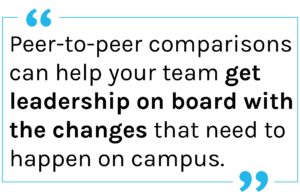How can you examine performance management through a DEI lens?

Human resources teams have a role to play in diversity, equity, and inclusion (DEI) initiatives on college and university campuses, and that role goes well beyond recruitment and hiring. Talent management is a key aspect of building and retaining diverse groups of faculty and staff, as well as achieving equitable and inclusive campus environments. Read on to learn more about how to examine your institution’s performance management practices through a DEI lens.
Employee engagement and retention
As noted by Nonprofit HR, “After years of research… we can all agree that employee engagement is directly tied to performance results. Those employees who have picked up on… systemic biases living within individuals and organizations, those who do not feel utilized or leveraged, or those who know they do not have a real seat at the table, are not engaged.” The problem is multi-faceted. An employee who is not engaged—someone who doesn’t feel supported or included—is unlikely to perform their role to their best capacity, and probably less likely to be promoted.
Similarly, a manager who sees a faculty or staff member underperforming might rely on traditional performance management measures that don’t probe into why that employee is underperforming—and might miss warning signs that the employee is experiencing bias or discrimination in their work environment. Many campuses are asking the same question: how do we retain a diverse faculty and staff? That’s why it’s important for your team to examine your institution’s performance management practices.
Re-evaluating performance management practices
One performance management practice that can be problematic is general, open-ended questions that rely on a manager’s expectations for an employee. Such questions leave lots of room for personal opinions to get in the way of an un-biased review. Instead, consider the following:
- Make performance reviews specific to a department, school, or role type to ensure that employees are being evaluated on things relevant to their position—a digital performance management tool is key for customized reviews.
- Unstructured systems can leave a lot of room for inequities, so standardization is key. Don’t leave every department to create their own system from scratch.
- Engaging multiple reviewers can also help reduce the potential for bias, ensuring that more than one take on a situation is included.
- Create opportunities outside the traditional review cycle to give managers a chance to understand what might be impacting an employee’s performance.
 For instance, NYU has implemented several programs to help the institution retain diverse talent, including “’stay interviews’… to better understand what motivates and keeps staff engaged so that more of those opportunities can be offered.” In an article about NYU’s programs, NACE wrote, “Many times, even the most engaged staff leave and leadership do not learn of the reason until an exit interview is conducted. ‘Stay interviews’ allow managers to understand their direct reports, what motivates them and makes them happy, and what keeps them engaged.”
For instance, NYU has implemented several programs to help the institution retain diverse talent, including “’stay interviews’… to better understand what motivates and keeps staff engaged so that more of those opportunities can be offered.” In an article about NYU’s programs, NACE wrote, “Many times, even the most engaged staff leave and leadership do not learn of the reason until an exit interview is conducted. ‘Stay interviews’ allow managers to understand their direct reports, what motivates them and makes them happy, and what keeps them engaged.”
Use your data
It’s important to start examining your performance management and retention practices using data, so your team knows exactly where your institutions stand. From retention metrics compared with hiring, as well as metrics by school or department, you can uncover where breakdowns might be happening.
Another notable NYU program was launched after surveys and metrics revealed a significant number of faculty and staff had experienced exclusionary or hostile conduct in the workplace based on their marginalized identity. NYU tied this information back to a lack of upward mobility for marginalized groups on campus. The university is now working on internal pipeline programs including mentorship and sponsorship to create opportunities for leadership and promotion. When examining your data, where do you see signs of a lack of belonging and inclusion? Consider creating mentorship opportunities in these areas.
Data is also important to hold institutional leadership accountable. CUPA HR recommends using “performance indicator data … so that HR can hold leadership accountable on whether steps are being taken to move the needle on DEI.” Being sure to include data-driven recommendations, visual metrics, and peer-to-peer comparisons can help your team get leadership on board with the changes that need to happen on campus.
being taken to move the needle on DEI.” Being sure to include data-driven recommendations, visual metrics, and peer-to-peer comparisons can help your team get leadership on board with the changes that need to happen on campus.
Dive in
HR can make a difference on campus. Don’t be afraid to re-examine the way things have always been done, engage in uncomfortable discussions, and dig into the data to understand what’s happening with DEI on your campus. For help with a data-driven driven approach to talent management, reach out to PeopleAdmin.